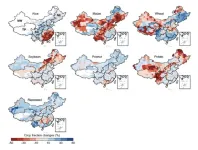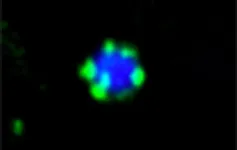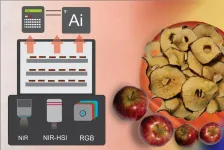(Press-News.org) Around the globe day and night, the microelectronics behind much of modern technology help run computers, medical devices and state-of-the-art instruments that power scientific discoveries. But all of that technology consumes energy, and adding artificial intelligence to the mix increases our energy needs dramatically. Some experts caution that this pace of energy usage is unsustainable.
To tackle this challenge, the Department of Energy (DOE) has announced funding $179 million for three Microelectronics Science Research Centers that bring together multi-institutional, multidisciplinary projects in partnership with industry. The centers are organized around making microelectronics more energy efficient and able to operate better in extreme environments.
The DOE’s SLAC National Accelerator Laboratory will lead two projects in the Microelectronics Energy Efficiency Research Center for Advanced Technologies (MEERCAT). The lab will also partner in projects for the Extreme Lithography & Materials Innovation Center (ELMIC) and Co-design & Heterogeneous Integration for Microelectronics in Extreme Environments (CHIME) center.
“Advancements in microelectronics are critical to furthering scientific discovery,” said Harriet Kung, DOE Office of Science Deputy Director for Science Programs. “The innovations that come from these research centers will improve our daily lives and drive forward U.S. leadership in science and technology.”
Reimagining microelectronics for energy efficiency
Existing methods for shrinking devices are approaching their limits, so researchers must find a fresh approach to microelectronics that balances demands for more computing power and handling more data while reducing energy consumption. To address these challenges, MEERCAT is poised to innovate the design and discovery of new materials, devices and systems architectures for microelectronics to push the limits of current computing and sensing capabilities, critical areas for the DOE scientific mission.
The center will host Enabling Science for Transformative Energy-Efficient Microelectronics (ESTEEM), a project led by Paul McIntyre, SLAC associate lab director for the Stanford Synchrotron Radiation Lightsource, and includes partners from Stanford University, Georgia Institute of Technology, Northwestern University, University of Tennessee, Knoxville, and University of Texas, San Antonio. The team will concentrate on advancing new methods for manufacturing, metrology, design and simulation of energy-efficient microelectronics, including discovery of nanostructured materials, new device architectures and software-hardware integration.
In their quest, researchers are “finding ways to vertically stack devices through new manufacturing methods,” said McIntyre, and looking to the human brain for inspiration. For example, instead of improving the current computer hardware configuration, where data is shuttled back and forth through relatively long wires connecting separate logic and memory chips, the team will integrate several functions into the same component or device.
“The brain is a very energy-efficient system compared to a silicon-based computer,” said McIntyre.
Implementing these ideas will require an “atoms-to-algorithms strategy” to control physical processes across wide-ranging distance and time scales and to map these processes to software. To optimize these efforts, the team will work on all of these areas simultaneously – an approach called co-design. SLAC brings its world-leading X-ray and ultrafast instruments and cryogenic electron microscopes to this challenge, as well as expertise in materials science and device design.
Wrangling a deluge of data
State-of-the-art instruments across the DOE national laboratories speed scientific discovery and generate massive amounts of data at blazing speeds. Conventional methods of saving data and then analyzing it on a computer will no longer be sufficient, so researchers are turning to extracting useful information in real time by reimagining many aspects of the data collection and analysis process of sensing systems – networks of sensors that detect and measure environmental phenomena.
Also part of MEERCAT, the Adaptive Ultra-Fast Energy-Efficient Intelligent Sensing Technologies (AUREIS) project, led by Angelo Dragone, SLAC deputy associate lab director in the Technology Innovation Directorate, will focus on redesigning the sensing systems to intelligently process and analyze the raw data as close to the sensor as possible, reducing the amount of data that arrives to the computer. Through co-design, the team, composed of researchers from across SLAC and collaborators from six other national laboratories and universities, will explore new materials, computing architectures, AI and machine learning algorithms and fabrication processes to develop adaptive, ultrafast, intelligent and energy-efficient sensing technologies.
“We have long-standing expertise and capabilities at the lab in developing detectors for X-ray science and high energy physics,” said Dragone. “At the same time, we leverage AI and machine learning to support complex workflows and edge computing.” Between SLAC and the partner institutions, the AUREIS team will have access to world-class facilities for the design, fabrication and characterization of sensors and circuits, for example, the Stanford Nanofabrication Facility and Stanford Nano Shared Facilities; the SLAC Shared Science Data Facility; and the design, assembly and test facilities within the SLAC Instrumentation Division.
Other partners in this project include researchers from Argonne National Laboratory, Brookhaven National Laboratory, Fermi National Accelerator Laboratory (Fermilab), Lawrence Berkeley National Laboratory, Lawrence Livermore National Laboratory, Stanford University, University of Hawaii, Manoa, and GE Vernova.
Targeting microelectronics in extreme environments
Making and operating microelectronics devices can involve extremely cold, high radiation and high magnetic field environments. SLAC’s work on scientific instruments for high-energy physics experiments, quantum sensing and ultrafast X-ray science brings unique expertise in designing semiconductors, microelectronics circuits and systems to work in such extreme environments.
The goal of the ELMIC is to integrate new materials and processes for future microelectronics, focusing on areas such as plasma-based nanofabrication, extreme ultraviolet (EUV) sources and new materials systems just a few atoms or molecules thick, known as two-dimensional materials.
Siegfried Glenzer, director of SLAC’s High Energy Density Science division, will partner in the High Conversion Efficiency 2 um (micrometer) Laser-Driven Sources for EUV Lithography and Plasma Science project, led by Lawrence Livermore National Laboratory. To make chips in a more energy efficient manner, the team is working on a novel plasma source that can emit light in the extreme ultraviolet wavelength. The project will use SLAC’s advanced technology in target systems, which help with alignment and measurements, and expertise in laser-plasma interactions.
Meanwhile, CHIME will bring together projects that optimize and advance next-generation technologies from the atomic scale to the fully integrated instrument for use in challenging environments.
Within CHIME, Technology Innovation Directorate staff scientist Lorenzo Rota is partnering in the Fermilab-led Single Photon Detectors Integrated with Cryogenic Electronics (SPICE) project, which aims to develop advanced devices for detecting fundamental particles, shedding light on how the universe works. To facilitate these cutting-edge experiments, the SPICE team will focus on the co-design and integration of new materials, sensors and circuits operating at extremely cold temperatures. The project will draw upon SLAC’s extensive experience in designing important components in these detectors, called image sensors, and in designing and developing X-ray detectors for scientific exploration.
“The DOE centers address our growing energy needs by driving fundamental research for developing novel and advanced microelectronics technologies,” said John Sarrao, laboratory director. “We are grateful for this opportunity to collaborate with our partners in the microelectronics ecosystem through this innovative co-design approach.”
The Microelectronics Science Research Centers are funded by the DOE Office of Science. SSRL and LCLS are DOE Office of Science user facilities.
END
SLAC will play a key role in DOE’s new research centers for advancing next-generation microelectronics
The microelectronics that power daily life and speed discoveries in science and technology are the focus of a bold new vision to make them more energy efficient and able to operate in extreme environments.
2025-01-07
ELSE PRESS RELEASES FROM THIS DATE:
Market researchers and online advertisers, are A-B tests leading you astray? A new study says they could be
2025-01-07
Researchers from Southern Methodist University and University of Michigan published a new Journal of Marketing study that examines platforms’ A-B testing of online ads and uncovers significant limitations that can create misleading conclusions about ad performance.
The study, forthcoming in the Journal of Marketing, is titled “Where A-B Testing Goes Wrong: How Divergent Delivery Affects What Online Experiments Cannot (and Can) Tell You About How Customers Respond to Advertising” and is authored by Michael Braun and Eric M. Schwartz.
Consider a landscaping company whose designs focus ...
Research alert: Ketamine use on the rise in U.S. adults; new trends emerge
2025-01-07
A recent study analyzing data from the National Survey on Drug Use and Health (NSDUH) found that past-year recreational ketamine use among adults has increased dramatically since 2015, including significant shifts in associations with depression and sociodemographic characteristics such as race, age and education status. Ketamine use has shown promise in clinical trials therapy for several mental illnesses, including treatment-resistant depression, and the new research suggests that ongoing monitoring of recreational use trends is crucial to balancing these ...
Crop switching for climate change in China
2025-01-07
A study of Chinese agriculture recommends planting areas currently growing maize and rapeseed with alternative crops to reduce environmental costs while maximizing food production as the climate changes.
Chinese food production has nearly doubled since the 1980s, mainly thanks to intensified nutrient usage and irrigation. Given that China’s demand for food is forecast to increase further, Qi Guan and colleagues modeled the country’s agricultural system under varying climate change scenarios in the 21st century, using a dynamic global vegetation model. The authors created scenarios ...
Cell-based therapy improves outcomes in a pig model of heart attacks
2025-01-07
BIRMINGHAM, Ala. – In a large-animal model study, researchers have found that heart attack recovery is aided by injection of heart muscle cell spheroids derived from human induced pluripotent stem cells, or hiPSCs, that overexpress cyclin D2 and are knocked out for human leukocyte antigen classes I and II. This research, published in the journal Circulation Research, used a pig model of heart attacks. Pig hearts more closely resemble the human heart in size and physiology, and thus have a higher clinical relevance to human disease, compared to studies in mice.
University of Alabama at Birmingham researchers, led by Jianyi “Jay” ...
Researchers have a better understanding of how our cells dispose of waste while developing ways to control it
2025-01-07
Recycling takes place in our cells at all times: in a process called autophagy, cell components that are no longer needed are enclosed by membranes and broken down into their basic building blocks. This vital process prevents the formation of harmful aggregates and makes nutrients available again. A research team co-led by Prof. Dr. Claudine Kraft from the CIBSS Cluster of Excellence at the University of Freiburg and Dr. Florian Wilfling from the Max Planck Institute of Biophysics in Frankfurt has now discovered the conditions necessary for autophagy to start. They were also able ...
Earth’s air war: Explaining the delayed rise of plants, animals on land
2025-01-07
New Haven, Conn. — If you like the smell of spring roses, the sounds of summer birdsong, and the colors of fall foliage, you have the stabilization of the ozone layer to thank for it. Located in the stratosphere, where it shields the Earth from harmful ultraviolet radiation, the ozone layer plays a key role in preserving the planet’s biodiversity.
And now we may have a better idea of why that took so long — more than 2 billion years — to happen.
According to a new, Yale-led study, ...
More than half of college students report alcohol-related harms from others
2025-01-07
FOR IMMEDIATE RELEASE
Tuesday, January 7, 2025
Contact:
Jillian McKoy, jpmckoy@bu.edu
Michael Saunders, msaunder@bu.edu
##
More than half of US college students experienced alcohol-related harms caused by others, according to the first national probability-based survey of such harms conducted in 20 years. The findings, published in the journal Drug and Alcohol Review in December, shed light on how others’ drinking affects students’ health, academics, and safety.
“Our research ...
Smart food drying techniques with AI enhance product quality and efficiency
2025-01-07
URBANA, Ill.– Food drying is a common process for preserving many types of food, including fruits and meat; however, drying can alter the food’s quality and nutritional value. In recent years, researchers have developed precision techniques that use optical sensors and AI to facilitate more efficient drying. A new study from the University of Illinois Urbana-Champaign discusses three emerging smart drying techniques, providing practical information for the food industry.
“With traditional drying systems, you need to remove samples to monitor the process. But with smart drying, or precision drying, you can continuously ...
Typical cost of developing new pharmaceuticals is skewed by high-cost outliers
2025-01-07
The typical cost of developing new medications may not be as high as generally believed, with a few ultra-costly medications skewing public discussions about the cost of pharmaceutical research and development, according to a new RAND study.
Using a novel method to assess spending on research and development for 38 drugs that were recently approved by the U.S. Food and Drug Administration, researchers found that the mean, or average, cost of developing a new drug was much higher than the mid-point (median) cost of development.
Researchers estimated a median direct research and development cost of $150 million compared to a mean of $369 million.
Costs ...
Predicting the progression of autoimmune disease with AI
2025-01-07
HERSHEY, Pa. — Autoimmune diseases, where the immune system mistakenly attacks the body’s own healthy cells and tissues, often have a preclinical stage before diagnosis that’s characterized by mild symptoms or certain antibodies in the blood. However, in some people, these symptoms may resolve before culminating in the full disease stage.
Knowing who may progress along the disease pathway is critical for early diagnosis and intervention, improved treatment and better disease management, according to a team led by researchers from the ...
LAST 30 PRESS RELEASES:
Archaeologists use AI to create prehistoric video game
Mitochondria migrate toward the cell membrane in response to high glucose levels
Tiny viral switch offers hope against drug-resistant bacteria
Most parents aware of early peanut introduction guidelines, but confused about details
HPV vaccine can protect against severe lesions of the vulva and vagina
Virtual care provision and emergency department use among children and youth
Quadrivalent HPV vaccine and high-grade vulvovaginal lesions
Insights into dry eyes gained from stem cell-derived tear glands
Researchers identify 166 human pluripotent stem cell lines available for use in clinical applications
Europa Clipper instrument uniquely observed interstellar comet 3I/ATLAS
UN University Report challenges climate change as sole trigger of Syrian Civil War, exposing governance failures in drought response
Real estate investment trust (REIT) acquisition associated with hospital closure and bankruptcy
New Raman imaging system detects subtle tumor signals
Boston Children’s receives a $7.5 million grant from Aligning Research to Impact Autism (ARIA) to provide clinical research coordination for the IMPACT Network
Spray-on antibacterial coating offers new protection for plants against disease and drought
ESMT Berlin study: What makes a first offer successful in negotiations
Groundbreaking ceremony marks the beginning of CTAO-South Array construction in Chile
Why swearing makes you stronger
What prevents more cancer patients from enrolling in potentially life-saving clinical trials?
UK’s worst-case climate risks laid bare for lawmakers
A decline in churchgoing linked to more deaths of despair
TAMEST announces Maralice Conacci-Sorrell, Ph.D., UT Southwestern Medical Center, as 2026 Mary Beth Maddox Award & Lectureship Recipient
Global study to evaluate whether dengue outbreaks can be anticipated earlier
Chonnam National University researchers propose innovative voltage-loop control for power factor correction
Accelerating next-generation drug discovery with click-based construction of PROTACs
Detecting the hidden magnetism of altermagnets
$7M gift supports health research, engineering and athletics at UT San Antonio
NU-9 halts Alzheimer’s disease in animal model before symptoms begin
Hospitals acquired by real estate investment trusts associated with greater risk of bankruptcy, closure
City of Hope scientists study rare disorder to uncover mechanism and hormone regulation underlying fatty liver disease and sweet aversion
[Press-News.org] SLAC will play a key role in DOE’s new research centers for advancing next-generation microelectronicsThe microelectronics that power daily life and speed discoveries in science and technology are the focus of a bold new vision to make them more energy efficient and able to operate in extreme environments.





